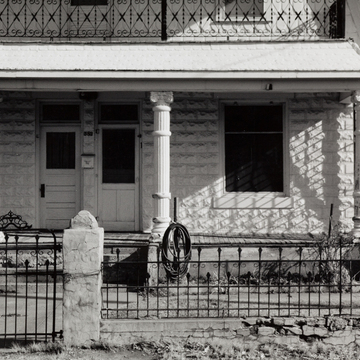Lay Street has many houses representative of popular styles, but it also has some exceptional structures that display the creative spirit of vernacular builders. Kluncy's Apartments is one of these. Bert Kluncy, a German immigrant and one of Winnemucca's most prosperous ranchers in the early twentieth century, built the apartments in the form of a large single-family residence, perhaps to fit better into the streetscape or to allow tenants to give the impression that they were prosperous homeowners. Stock construction materials account for the building's unusual appearance. The two-story-high walls are made of rock-faced concrete blocks, seen in other residential buildings in town. Iron tiles made to resemble red clay tiles cover the gambrel roof. Two porches, one on each side, run across the facade. A small porch with a mansard roof topped by a wrought iron railing projects from the east side of the building on the first story. Ornate cast concrete columns with fluted and banded shafts and Ionic capitals support the two first-floor porches; an ornate wrought iron railing decorates the second-story porch. Pressed metal shingles line the pediment of the front gambrel. The only alteration is the addition of a roof and posts on the second-story porch. The iron gate surrounding the lot is original.
You are here
Kluncy's Apartments
If SAH Archipedia has been useful to you, please consider supporting it.
SAH Archipedia tells the story of the United States through its buildings, landscapes, and cities. This freely available resource empowers the public with authoritative knowledge that deepens their understanding and appreciation of the built environment. But the Society of Architectural Historians, which created SAH Archipedia with University of Virginia Press, needs your support to maintain the high-caliber research, writing, photography, cartography, editing, design, and programming that make SAH Archipedia a trusted online resource available to all who value the history of place, heritage tourism, and learning.














